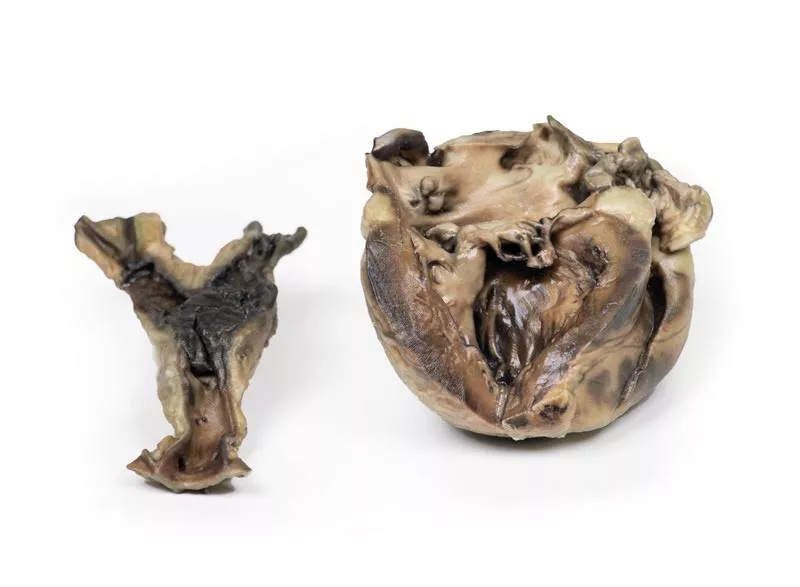Produktinformationen "Tetralogy of Fallot"
Klinische Vorgeschichte
Ein 21 Monate alter Junge wurde mit einer 2–3-monatigen Geschichte von Erschöpfung und Belastungsdyspnoe aufgenommen. Es kam zu mehreren kurzen Episoden akuter Atemnot. Bei der Untersuchung zeigte sich zentrale Zyanose, Klubfinger und ein raues systolisches Herzgeräusch links parasternal. Die Katheteruntersuchung ergab eine Tetralogie von Fallot mit schwerem Lungenödem. Eine Willis-Potts-Anastomose wurde durchgeführt. Der Junge verstarb jedoch 12 Stunden nach der Operation infolge akuter Dyspnoe und Konsolidierung des linken Lungenlappens.
Pathologie
Von vorn betrachtet zeigt das Herz eine Hypertrophie des rechten Ventrikels sowie eine Verengung des Ausflusstrakts zur Pulmonalklappe. Die pulmonale Klappe ist bikuspid und verengt, darunter liegt eine Endokardfibrose. Die Aorta liegt über einem großen Ventrikelseptumdefekt (VSD) und kommuniziert mit dem rechten Ventrikel. Eine Sonde kann vom verengten Truncus pulmonalis über die dilatierte linke Pulmonalarterie durch die Anastomose in die Aorta descendens geführt werden. Rückseitig zeigen sich zwei Atriumseptumdefekte (ASD). Die Wand des linken Ventrikels ist dünner als die des rechten.
Weitere Informationen
Die Tetralogie von Fallot besteht aus vier Hauptmerkmalen: 1. Ventrikelseptumdefekt, 2. Überreitende Aorta, 3. pulmonale Stenose und 4. rechtsventrikuläre Hypertrophie. Die Zyanose tritt meist früh auf und hängt vom Ausmaß der Obstruktion im Ausflusstrakt ab. Unbehandelte Patienten können unter Umständen bis ins Erwachsenenalter überleben, jedoch ist heute eine chirurgische Korrektur üblich. Zusätzliche Herzfehler wie ASD können vorkommen. Mögliche genetische Ursachen sind Trisomie 21 oder das DiGeorge-Syndrom.
Ein 21 Monate alter Junge wurde mit einer 2–3-monatigen Geschichte von Erschöpfung und Belastungsdyspnoe aufgenommen. Es kam zu mehreren kurzen Episoden akuter Atemnot. Bei der Untersuchung zeigte sich zentrale Zyanose, Klubfinger und ein raues systolisches Herzgeräusch links parasternal. Die Katheteruntersuchung ergab eine Tetralogie von Fallot mit schwerem Lungenödem. Eine Willis-Potts-Anastomose wurde durchgeführt. Der Junge verstarb jedoch 12 Stunden nach der Operation infolge akuter Dyspnoe und Konsolidierung des linken Lungenlappens.
Pathologie
Von vorn betrachtet zeigt das Herz eine Hypertrophie des rechten Ventrikels sowie eine Verengung des Ausflusstrakts zur Pulmonalklappe. Die pulmonale Klappe ist bikuspid und verengt, darunter liegt eine Endokardfibrose. Die Aorta liegt über einem großen Ventrikelseptumdefekt (VSD) und kommuniziert mit dem rechten Ventrikel. Eine Sonde kann vom verengten Truncus pulmonalis über die dilatierte linke Pulmonalarterie durch die Anastomose in die Aorta descendens geführt werden. Rückseitig zeigen sich zwei Atriumseptumdefekte (ASD). Die Wand des linken Ventrikels ist dünner als die des rechten.
Weitere Informationen
Die Tetralogie von Fallot besteht aus vier Hauptmerkmalen: 1. Ventrikelseptumdefekt, 2. Überreitende Aorta, 3. pulmonale Stenose und 4. rechtsventrikuläre Hypertrophie. Die Zyanose tritt meist früh auf und hängt vom Ausmaß der Obstruktion im Ausflusstrakt ab. Unbehandelte Patienten können unter Umständen bis ins Erwachsenenalter überleben, jedoch ist heute eine chirurgische Korrektur üblich. Zusätzliche Herzfehler wie ASD können vorkommen. Mögliche genetische Ursachen sind Trisomie 21 oder das DiGeorge-Syndrom.
Erler-Zimmer
Erler-Zimmer GmbH & Co.KG
Hauptstrasse 27
77886 Lauf
Germany
info@erler-zimmer.de
Achtung! Medizinisches Ausbildungsmaterial, kein Spielzeug. Nicht geeignet für Personen unter 14 Jahren.
Attention! Medical training material, not a toy. Not suitable for persons under 14 years of age.





































